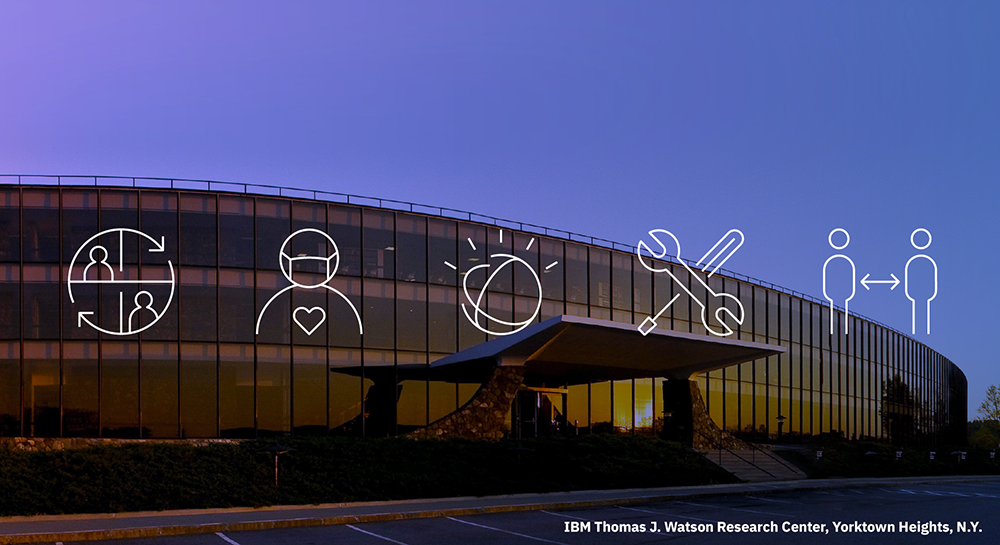Smarter Strategies
Insights and best practices for digital transformation
AT&T and IBM: Helping Businesses Adapt to New Work Environments
By Mo Katibeh and Steve Canepa
In coping with the coronavirus crisis, organizations around the world have been using digital technology to continue operating their businesses remotely while they wait for the world to return to normal—or at least to settle into the next normal.
From that crisis has come an opportunity: to accelerate the business world’s digital transformation. That’s why AT&T and IBM, building on our long-standing collaboration, are now focused on the use of 5G wireless networking and edge computing as key ways to help enterprises emerge smarter, more efficient and more resilient as they get fully back to business.
IBM, at its storied Thomas J. Watson Research Center, is deploying AT&T’s 5G and multi-access edge computing (MEC)—a private cellular, low latency solution that can process data on a business site’s premise, instead of routing traffic over public networks.

As America looks ahead, technologies like 5G and edge are poised to play a huge role in building the future of virtually all industries. Enhanced by artificial intelligence (AI), these technologies promise to deliver the low-latency, high-performance computing and security requirements that many industries may require to be competitive in the post-pandemic future.
AT&T and IBM plan to implement many of these at the Watson research center. There, where scientists and researchers are engaged in activities that don’t always readily translate into the remote-work routines that businesses have been forced to adopt in recent months, our two companies are creating what we hope can be a showcase for 5G and edge capabilities.
Combining 5G with edge computing, for example, could open the door to breakthroughs in robotics and the ability to perform intricate machine work from remote locations. One of the tasks we are exploring at Yorktown Heights envisions enabling a researcher to remotely adjust locations of IoT network devices in a laboratory. Another envisions allowing a systems administrator to remotely rewire machines in a data center to provide a more agile environment.
Together, AT&T and IBM want to demonstrate how industries of all sorts can make a smooth transition into the new work environments that can help define the future of business. This model is highly suited to building applications that can accelerate innovations in industries, including manufacturing, healthcare, energy and utilities.
Foundation for a New Approach to Work
The path to the future, of course, begins with emphasizing employee safety as we enable work that is best done at shared locations. The remote working capabilities enabled by 5G’s low-latency, high-performance connectivity give us the tools to help businesses address concerns about spreading COVID-19 in a workplace, and lay a foundation for an eventual return to workplaces.
At Yorktown Heights, our companies will be deploying Watson Works, a set of return-to-work solutions designed to offer a range of capabilities for businesses.
We are addressing workplace safety in a system driven by IBM AI and made feasible at scale by AT&T LTE and 5G mobile network technologies. That includes AT&T MEC. This solution from AT&T enables the development and deployment of new capabilities that rely on ultra-low latency, higher security and privacy, improved bandwidth conservation and greater control of data.
The low latency of 5G allows for remote operations in industrial settings, helping to keep workers from harmful situations. And if any dangerous situations do arise, edge computing is designed to let businesses capture and analyze data quickly without extra storage or processing on a central cloud.
That same processing ability can help employees look after their health with devices to monitor their temperature, oxygen levels and blood pressure with instantaneous feedback. Hospitals can even take advantage of similar advances to make their current infrastructures more reliable, while implementing advances like wireless surgery, robotics, virtual reality simulations.
Even in a lower-risk setting like a retail shop, 5G and edge can help stores analyze supply chain data, detect spills or spoilage, or monitor metrics like crowd density in ways that would have overwhelmed a network without edge computing.
Long-Time Collaborators in Digital Transformation
AT&T and IBM have a deep relationship and a years-long history of collaboration. This relationship proved its value when it came to serving AT&T and IBM’s joint enterprise customers amid the disruptions from COVID-19. AT&T was able to respond to its customers’ new needs in doing business remotely, and deliver the capabilities required to keep its customers’ businesses running.
IBM and AT&T were able to quickly respond to the pandemic, migrating to a work-from-home operating model to help keep employees safe. Massive infrastructure upgrades were executed in days, with some business units requiring a 200 percent increase in remote workforce infrastructure capacity. Within 3 weeks, the builds were complete, and the employees from both companies were working from the safety of their homes to support customers.
That population included IBM and AT&T employees who help support AT&T’s thousands of business customers relying on internet and phone services. These organizations efficiently processed a 20 percent surge in orders as business customers quickly moved to their own remote operations. Even after the pandemic subsides, re-engineered processes are expected to remain in place for customers who require expedited order fulfillment.

The Promising Path Ahead
AT&T’s strategy of deploying both its nationwide 5G network operating below 6 gigahertz and its mmWave spectrum bands of 24GHz and higher will help provide the best mix of speeds, latency and coverage for business needs. As part of this installation, AT&T 5G mmWave coverage will be available at the Yorktown Heights facility.
The collaborative showcase that AT&T and IBM are creating at Yorktown Heights, with 5G and MEC enhanced by AI, intends to demonstrate many of the capabilities of low-latency, high-performance, secure computing that could be applicable to many industries in the post-pandemic future.
- The healthcare industry could more rapidly adopt solutions for containing pandemics, monitoring patients and ensuring worker safety, while enabling management to embrace more agile forms of operation.
- Manufacturing companies could reduce costs through 5G-connected automated operations and help improve production line quality with robotics and near real-time visual analysis.
- Energy and utility firms could deploy edge services in their next-generation Advanced Meter Infrastructure as they upgrade their electricity grids to power electric vehicles and more seamlessly integrate renewable energy production and storage.
- Operators of public facilities could enhance the safety of workers and patrons through near real-time health monitoring, self-reported employee temperature data, and occupancy and crowd-density management.
- Enhanced networking and remote monitoring, combined with automated inventory management and AI-enhanced procurement processes could help create more resilient and dynamic supply chains for any type of industry, whatever the potential source of disruption.
- Employers of all types, but especially in heavy industries, could benefit from worker safety solutions that combine AI and machine learning with high-speed networking. Those could help make it possible to respond to an incident much faster and initiate near-instant decision-making that might include shutting down operations and evacuating buildings.
The COVID-19 crisis is not over, but it won’t last forever. By spurring the accelerated adoption of technologies that are vital to any organization’s digital transformation—particularly AI, 5G and edge computing—the response to this crisis can help businesses not only survive, but be poised to thrive in the future.

Mo Katibeh is Chief Product and Platform Officer at AT&T Business.

Steve Canepa is General Manager of the Global Communications Sector at IBM.
Statements regarding IBM's future direction and intent are subject to change or withdrawal without notice, and represent goals and objectives only.